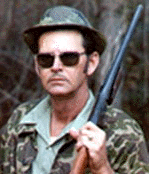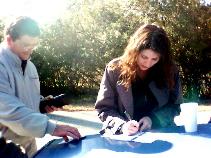 |
HONEY ISLAND SWAMP MONSTER |
|||||
| Web Site Courtesy of MK Davis & Jay Michael Plan an Expedition! -LINKS- Encounters With the Honey Island Swamp Monster Legend of the Swamp Tracking the Swamp Monster (Skeptical) Tripsmarter Louisiana |
plaster into them. With this
proof Harlan contacted the Louisiana Wildlife Commission
and zoologist at the Louisiana State University. All who
examined the casts determined they were not a hoax and
were made by an unidentifiable animal. The weight of the
creature was estimated at about 400 pounds. |
A discussion of the
evidence
collected by M.K.Davis concerning the animal seen by
Harlan Ford and Billy Mills , in the Honey Island swamp ,
near Pearl River Louisiana... Honey
Island Swamp Monster Info. And Conclusions
|
||||
| The Ted Williams Story Ted Williams lived on the bayou most of
his life. He was a trapper and worked on the swampland
every day. Ted claimed to have seen the creature many
times, and he knew there was more than just one of them.
He said, "I could have killed them, but I didn't
cause they didn't seem to want to harm me. I'd see them
swimming the river and get out on the bank then
dissappear in the swamp." One day while fishing one
crossed the river and walked right past him. One day Ted
took his boat deep in the swamp to set trout lines. He
was never seen again. No one has ever found him or his
boat. Video available on Video Page. |
Is the Honey
Island Swamp Monster a Bigfoot? Read these reports from
the GCBRO database of Bigfoot type creatures seen in and
near the Honey Island Swamp! |
|||||
| Many folks believe the Honey Island Swamp
Monster is just a large gator lurking about in the
swamps. Our team of investigators have produced the
following evidence to reject that claim: This is a comparison of the Honey Island Track and a local Alligator track. Though the tracks are similar, they are not the same.
|
An analysis of eye witness reports , regarding the possible nature of the animal. by M.K.Davis First of all I would like to start off with the testimony of South Louisiana resident Ted Williams, who's interview was featured on the Alan Landsburg show " In Search Of." I will also comment on information taken from interviews with Perry Ford and Dana Holyfield regarding Mr. Williams story. Some of Mr. Williams interview is featured on this website. 1. Mr. Williams stated that the first time he saw it , he thought it was a stump. He said it was about seven feet high. Well...we can assume that it was between six and eight feet tall and be safe. It seems that it would have been a mighty big stump. You have to go to the area to appreciate how tall some cypress stumps are . There are stumps that tall down there. 2. He said it jumped a bayou. I don't know if this was on two feet or four. When Harlan Ford first saw it , it was on four, but raised up on two legs , and then ran off on two. However , according to Perry Ford , it appeared to go down again on all fours , as it went into the thicket. 3. Mr. Williams stated that it had hands , almost like a human's. Well almost , is not completely like a human's hand. The people down there in South Louisiana , who regularly go into the swamp , are astute observers of the flora and fauna. It's safe, in my opinion, to say that the creature's hands are not completely like a human's. Harlan Ford said that he found where the animal went down on it's front feet to drink, and the print revealed it had heavily clawed front feet. 4. The animal was observed swimming the Pearl river , by Mr. Williams. He said that they swam with long overhand strokes, like a human. He said they were broad shouldered. I take this to mean that the shoulder motion would indicate a ball and socket shoulder joint. This would favor brachiation as a fair description of the animal. ( capable of hand over hand motion). This is both surprising and perplexing. This would be a primate trait. 5. Mr. Williams stated privately that two of the animals swam the river and ascended the embankment , close enough to him that they "shook water " on him. 6. These animals are described as having a "mane" of hair . Harlan Ford stated , according to his son Perry, that from behind , the animal reminded him of an African Lion. The musculature was similar. Interestingly enough, while interviewing another Local about the area , he mentioned to me that African Lions are seen from time to time. He was not aware of what Harlan Ford had described. There is no tail described. The face is said to be rather flat. 7. The most prominent feature described by Ford and others , is the size and color of the eyes. They appear to be disproportionately large , and of an amber color. Mr. Ford stated that this gave the animal a "sinister" look. 8. The tracks , left by the animal , appear to be somewhat similar to an Alligator's rear foot. Upon close examination , however, it becomes clear , that this is something different. I refer to my previous statement about the Locals observational skills. They had no problem at all distinguishing this track from an alligator , which they regularly kill , and eat. There are four toes visible. There are three heavily clawed toes , with prominent knuckles , underneath the foot. Then... there is the bizarre thumblike small toe . About an inch and a half on the cast that I have. These toes show clearly , that this animal can grasp with the toes. The three large toes , are long and slender , with tendons visible in the prints. The claws are turned down , and backwards to grip the loose soil , sand , and mud. This is reminiscent of a cat like trait. The skin appears to be thin on the bottom of the foot , with tendons showing. In the hostile environment of the island , thin skin under the foot would indicate that it didn't spend a lot of time on the ground. 9. On one occasion the animal was said to have killed three wild hogs , all found in the same area , with the distinctive tracks around them. All three were killed by bites to the throat. The last being still kicking and bleeding. None were eaten. This might mean , perhaps , that the animal , for some reason , was being territorial. Perhaps with young ones . The biting of the throat , would be a cat like trait. 10. Perry Ford spent the night fending off this animal by lighting off a fire. He stated that he first heard it way up the river. It was a loud " squall". It should be noted that these people know their sounds , and a "squall" is markedly different from a scream or roar. He said that the animal had cut the distance in half , by the time he heard it again. The animal was moving along the river rapidly. The third time he heard it was at close range. He said the "squall" was loud and similar in nature to an owl scream , but with leaf shaking resonation. The animal stayed near him , squalling and sounding as if it were "rolling logs over" , just out of sight of the firelight. Towards morning it left. A pack of dogs , later picked up the trail and ran the animal. 11. It's interesting to note that Mr. Williams was of the opinion that , the animals would not harm him. However, at a later date, Mr. Williams vanished into the swamp, without a trace. This is interesting in trying to determine the nature of the animal. Harlan Ford stated that upon making eye contact with it , it did not immediately run away , but appeared to look the situation over. Perhaps if Mr. Ford had not had his companion Billy Mills there with him , maybe he too would have vanished. Something to think about. M.K.Davis |
|||||
| IN SEARCH OF In
1978 the Alan Lamdsburg Company, producers of the popular
TV program, IN SEARCH OF did a segment on the Honey
island Swamp Monster. This catapulted the monster into
International fame. Since then there have been many
reports and the program has become a reference for
information on the creature. Here are a few screen shots
from that now infamous program: |
||||||




















